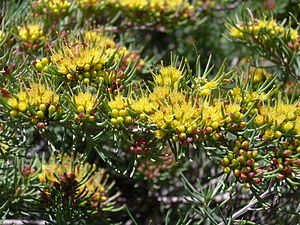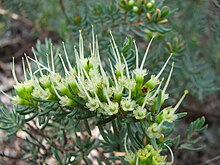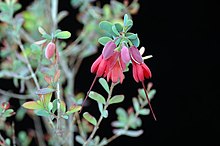Homoranthus
| Homoranthus | ||||||||||||
|---|---|---|---|---|---|---|---|---|---|---|---|---|

|
||||||||||||
| Systematics | ||||||||||||
|
||||||||||||
| Scientific name | ||||||||||||
| Homoranthus | ||||||||||||
| A. Cunn. ex showers |
Homoranthus is a genus of plants withinthe myrtle family (Myrtaceae). All about 31 species are originally found only in Australia .
description
Appearance and leaves
Homoranthus species grow as evergreen shrubs .
The opposite or decussate arranged on the branches leaves are often narrowed laterally so that the leaf blades thicker than they are wide, in the side view, they are linear, cylindrical to more or less upside down-lanceolate.
Inflorescences, flowers and fruits
In the upper leaf axils of undifferentiated branches there are reduced, capiform inflorescences that contain one to four flowers. Each flower stands over a pair of bracts , which are quickly perishable or remain during the anthesis (as long as the flower is open).
The hermaphroditic flowers are radial symmetry and five-fold with a double flower envelope . The flower cup (hypanthium) extends above the ovary and is usually five-ribbed. The sepals are completely fused or end in two to twelve slender fringed calyx lobes. The colors of the flowers are white or yellow to orange to red. The stamens are usually straight in the bud or rarely curved a few inward. Usually in one or two, rarely several circles, five or six more or less identical stamens are arranged. Ten fertile stamens alternate with ten staminodes . The spherical anthers open at the top with pores. Two carpels are a half under constant, single-chamber ovary grown. Two or ten anatropic ovules are arranged in basal placentation . The stylus, which protrudes conspicuously far from the flower envelope, has a ring of hairs below the scar.
The dry closing fruits are mostly single-seeded, rarely two-seeded nut fruits . The fruit is surrounded by the slightly enlarged flower cup.
Chromosome number
The chromosome numbers are 2n = 14, 16, 18 or 20, depending on the species.
Spread and endangerment
The genus Homoranthus is distributed with around 31 species on the southern and eastern Australian mainland. The species occur in the states of Queensland , New South Wales and South Australia .
Homoranthus darwinioides , Homoranthus decumbens , Homoranthus lunatus , Homoranthus montanus , Homoranthus porteri and Homoranthus prolixus are classified as "Vulnerable" = "at risk". No other species is considered threatened.
Systematics


The name Homoranthus comes from Allan Cunningham . The valid first publication of the genus homoranthus was in 1836 by Johannes Conrad Schauer in Article Genera Chamaelauciearum Nova Quaedam in Linnaea , vol 10, p 310. As Lectotypusart was homoranthus virgatus A.Cunn. ex shower set. The genus name Homoranthus is derived from the Greek words homoros for “to be adjacent” or “to border” and anthos for “flower”, this refers to the similarity of the flowers of closely related genera such as Darwinia . The current revision of the genus Homoranthus comes from Lachlan M. Copeland, Lyn A. Craven & Jeremy J. Bruhl: A taxonomic review of Homoranthus (Myrtaceae: Chamelaucieae) , In: Australian Systematic Botany , Volume 24, Issue 6, 2011, p. 351-374.
Synonyms for Homoranthus A.Cunn. ex showers are: Darwinia sect. Homoranthus (A.Cunn. Ex Schauer) Kuntze , Rylstonea R.T.Baker , Chamelaucium sect. Schuermannia F. Muell. , Darwinia sect. Schuermannia (F.Muell.) Benth. , Schuermannia F. Muell. , Chamaelaucium sect. Schnermannia F. Muell. orth. var.
The genus Homoranthus belongs to the tribe Chamelaucieae in the subfamily Myrtoideae within the family Myrtaceae .
There are around 31 species of Homoranthus (as of 2011); here with information on distribution:
- Homoranthus bebo L.M. Copel. : Northeastern New South Wales.
- Homoranthus biflorus Craven & SRJones : Northeastern New South Wales.
- Homoranthus binghiensis J.T. Hunter : Northeastern New South Wales.
- Homoranthus brevistylis L.M. Copel. : Southeast Queensland.
- Homoranthus bruhlii L.M. Copel . : Northeastern New South Wales.
- Homoranthus cernuus (RTBaker) Craven & SRJones : East-Central New South Wales.
- Homoranthus clarksonii L.M. Copel. : Northeast Queensland.
- Homoranthus coracinus A.R. Bean : East-Central Queensland.
- Homoranthus croftianus J.T. Hunter : Northeastern New South Wales.
- Homoranthus cummingii L.M. Copel. : Northeast Queensland.
- Homoranthus darwinioides (Maiden & Betche) Cheel : Central New South Wales.
- Homoranthus decasetus Byrnes : Southeast Queensland.
- Homoranthus decumbens (Byrnes) Craven & SRJones : Southeast Queensland.
- Homoranthus elusus L.M. Copel . : Northeastern New South Wales.
- Homoranthus flavescens Showers : Northeastern New South Wales.
- Homoranthus floydii Craven & SRJones : Northeastern New South Wales.
- Homoranthus homoranthoides (F.Muell.) Craven & SRJones : South Australia .
- Homoranthus inopinatus L.M. Copel., J.Holmes & G.Holmes : Southeast Queensland.
- Homoranthus lunatus Craven & SRJones : Northeastern New South Wales.
- Homoranthus melanostictus Craven & SRJones : Southeast Queensland.
- Homoranthus montanus Craven & SRJones : Southeast Queensland.
- Homoranthus papillatus Byrnes : Southeast Queensland.
- Homoranthus porteri (CTWhite) Craven & SRJones : Northeast Queensland.
- Homoranthus prolixus Craven & SRJones (Syn .: Homoranthus bornhardtiensis JTHunter): Northeastern New South Wales.
- Homoranthus thomasii (F.Muell.) Craven & SRJones : North-Central Queensland.
- Homoranthus tricolor A.R.Bean : Southeast Queensland.
- Homoranthus tropicus Byrnes : Northern Queensland.
- Homoranthus vagans L.M. Copel. : Southeast Queensland.
- Homoranthus virgatus A. Cunn. ex showers : Southeast Queensland to northeast New South Wales.
- Homoranthus wilhelmii (F.Muell.) Cheel : South Australia.
- Homoranthus zeteticorum Craven & SRJones : East-Central Queensland.
use
Homoranthus flavescens is used as an ornamental plant in subtropical parks and gardens.
swell
- Lachlan M. Copeland, Lyn A. Craven & Jeremy J. Bruhl: A taxonomic review of Homoranthus (Myrtaceae: Chamelaucieae) , In: Australian Systematic Botany , Volume 24, Issue 6, December 21, 2011, pp. 351-374. doi : 10.1071 / SB11015
- GJ Harden: Entry in the New South Wales Flora Online .
Individual evidence
- ↑ a b c d e f g h GJ Harden: Entry in the New South Wales Flora Online . last accessed on January 18, 2013
- ^ A b c Lachlan M. Copeland, Lyn A. Craven & Jeremy J. Bruhl: A taxonomic review of Homoranthus (Myrtaceae: Chamelaucieae) , In: Australian Systematic Botany , Volume 24, Issue 6, December 21, 2011, p. 351 -374. doi : 10.1071 / SB11015
- ↑ EPBC Act List of Threatened Flora . last accessed on January 18, 2013
- ↑ First publication scanned at biodiversitylibrary.org .
- ↑ Entry in Tropicos . last accessed on January 18, 2013
- ↑ a b Entry in Australian Plant Name Index = APNI. last accessed on January 18, 2013
- ^ A b Thryptomene in the Germplasm Resources Information Network (GRIN), USDA , ARS , National Genetic Resources Program. National Germplasm Resources Laboratory, Beltsville, Maryland. last accessed on January 18, 2013
- ↑ a b c d e f g h i j k l m n o p q r s t u v w x y z aa ab ac ad ae af Rafaël Govaerts (Ed.): Homoranthus. In: World Checklist of Selected Plant Families (WCSP) - The Board of Trustees of the Royal Botanic Gardens, Kew . Retrieved January 18, 2013.
- ↑ Gordon Cheers (Ed.): Botanica. The ABC of plants. 10,000 species in text and images . Könemann Verlagsgesellschaft, 2003, ISBN 3-8331-1600-5 (therein page 449).
Web links
- Rodger Elliot: Shrubby Myrtles at Australian Plants Online . last accessed on January 17, 2013


